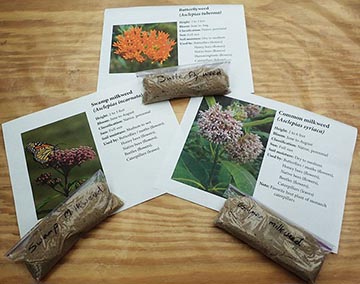When it comes to planting native seeds for pollinators, just scattering some seeds in a flower bed may not be enough. Some wildflowers will sprout like that, but the seeds of many species need to be treated before they will germinate. Those treatments may include going through the digestive tract of an animal to remove a hard seed coat that encapsulates the embryo or experiencing a winter to break the embryo’s dormancy. Often, this information is not included on the back of the seed packet which can make it really frustrating when almost none of your seeds germinate.

In my nursery, I can artificially simulate many of these treatments. The most common treatment is known as cold stratification and is simply a period of time when the seed is subjected to cold, moist conditions to simulate it going through a winter. The easiest way to do this is to mix the seeds with moist sand and put the mixture in a plastic bag in the refrigerator. Milkweed is an example of a seed that needs to experience a cold, wet period before it will germinate well.
Different species need to spend different amounts of time in the refrigerator and how long they spend in the refrigerator isn’t an exact science. There have been many times when my seeds have started to sprout in the refrigerator before my calendar said it was time to plant them. Germinating your own native seeds can be challenging but also rewarding. If you want to try growing your own native wildflowers from seed, make sure you 1) get good quality seed, 2) know and implement any treatments the seeds need in order to germinate, and 3) check the seeds often if they need a stratification period and plant immediately if they start to sprout.

This article was part of Shannon’s original Kentucky Pollinators and Backyard Wildlife blog which evolved into the blog for Backyard Ecology.

Backyard Ecology: Exploring Nature in Your Backyard
Nature isn’t just “out there.” It’s all around us, including right outside our doors. Hi, my name is Shannon Trimboli, and I am the host of Backyard Ecology. I live in southcentral Kentucky and am a wildlife biologist, educator, author, beekeeper, and owner of a nursery specializing in plants for pollinators and wildlife conservation. I invite you to join me as we ignite our curiosity and natural wonder, explore our yards and communities, and improve our local pollinator and wildlife habitat. Learn more or subscribe to my email list at www.backyardecology.net.

Leave a Reply